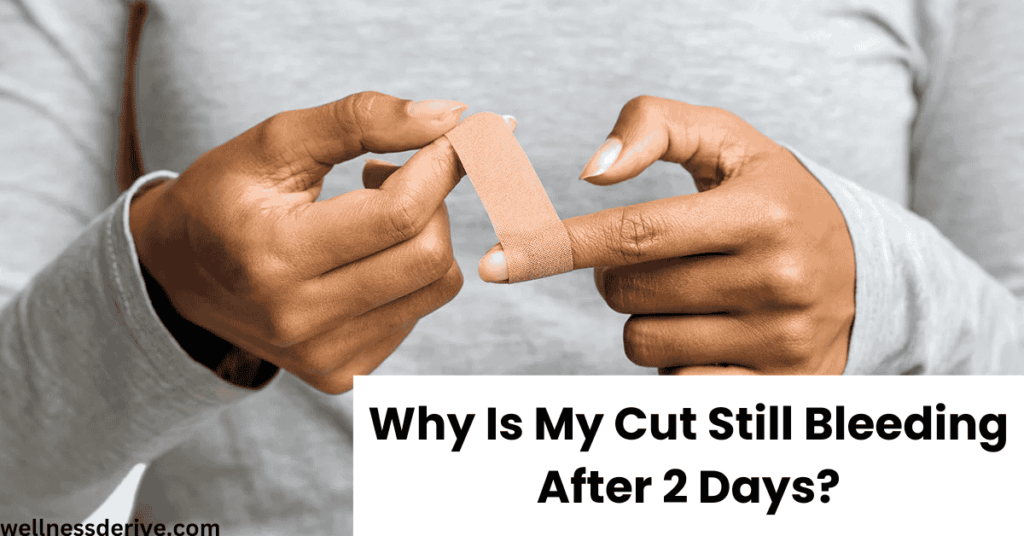Cuts and wounds are a common part of life, but if a cut continues to bleed for more than two days, it can raise concerns. Bleeding that persists beyond the normal healing period may indicate underlying issues, such as improper wound care, clotting disorders, or infection. This guide will explore the reasons why your cut might still be bleeding after 2 days, what it means, and how to manage it effectively.
What Causes a Cut to Bleed for 2 Days or More?
Several factors can contribute to prolonged bleeding from a cut. Here are the most common reasons:
1. Improper Wound Care
Inadequate cleaning, dressing, or care of a wound can prevent it from clotting properly.
- Signs: Blood seepage, redness, or swelling around the wound.
- Solution: Properly clean the cut with water and mild soap, then apply a sterile dressing to protect it.
2. Location of the Cut
Cuts on areas with thin skin, like fingers, or highly vascular regions, such as the scalp, may bleed longer due to the number of blood vessels.
- Why It Happens: More blood flow makes clotting harder in these areas.
3. Depth and Size of the Wound
Deeper cuts or those with jagged edges are more likely to bleed excessively and take longer to clot.
- Recommendation: Seek medical attention for deep wounds, especially if they gape or expose tissue.
4. Clotting Issues
Underlying clotting disorders or blood-thinning medications can impair the body’s ability to form clots.
- Examples: Hemophilia, von Willebrand disease, or medications like aspirin and warfarin.
5. Infection in the Wound
An infected wound can prevent proper healing and lead to prolonged bleeding.
- Symptoms: Increased redness, warmth, swelling, and pus formation.
6. Excessive Movement or Trauma
Moving the affected area or re-injuring the wound can disrupt the clot and restart bleeding.
What Does It Mean If My Cut Is Still Bleeding After 2 Days?
If your cut is still bleeding after two days, it might indicate one of the following:
- Inadequate Clot Formation: Your body hasn’t produced enough fibrin (a key clotting protein) to seal the wound.
- Reopening of the Wound: Movement or friction may have disrupted the healing process.
- Underlying Health Conditions: Chronic health issues, such as diabetes, can slow healing and cause prolonged bleeding.
Why Is My Cut Still Bleeding After 3 Days?
Bleeding after three days can be a sign of a more serious issue, such as infection, clotting problems, or the wound’s failure to heal due to improper care. If you notice persistent bleeding along with other symptoms like fever, swelling, or increasing pain, seek medical advice immediately.
How to Stop a Cut That Won’t Stop Bleeding
If you’re dealing with a cut that won’t stop bleeding, follow these steps to manage the wound effectively:
1. Apply Direct Pressure
Use a clean cloth or sterile gauze to apply firm pressure to the wound for 10–15 minutes without lifting.
2. Elevate the Wound
Raise the injured area above heart level to reduce blood flow and promote clotting.
3. Use a Bleed Stop Stick
Bleed stop sticks or powders can help clot blood quickly, especially for minor cuts.
4. Check for Embedded Objects
If there is debris in the wound, gently rinse it out with clean water before applying pressure.
5. Replace Dressings
If blood seeps through the dressing, apply additional gauze on top instead of removing the soaked layer, as removing it may disrupt the clot.
When Should You See a Doctor?
You should seek medical attention if:
- The cut is still bleeding after 48 hours despite proper care.
- You notice signs of infection, such as swelling, redness, warmth, or pus.
- The bleeding is excessive or caused by a deep or jagged wound.
- You have a known clotting disorder or are on blood-thinning medications.
- You feel dizzy, weak, or lightheaded due to blood loss.
Remedies for Prolonged Bleeding
If you experience prolonged bleeding, consider these remedies and tips:
1. Cold Compress
Apply a cold compress near the wound to constrict blood vessels and slow bleeding.
2. Antiseptic Solutions
Clean the wound with antiseptic to prevent infection, which can delay clotting.
3. Healthy Diet
Consume foods rich in vitamin K, iron, and protein to support healing and blood clot formation. Examples include spinach, kale, and lean meats.
4. Rest the Affected Area
Limit movement of the injured area to prevent reopening the wound.
Preventing Prolonged Bleeding in the Future
To reduce the risk of excessive or prolonged bleeding:
- Always clean wounds immediately and apply a sterile dressing.
- Avoid picking at scabs, as this can restart bleeding.
- Protect healing wounds from excessive movement or pressure.
- Stay hydrated and maintain a balanced diet to support overall health.
Common Questions About Bleeding Cuts
1. What Should You Do If Blood Seeps Through a Dressing on a Wound?
Apply additional gauze on top and continue applying pressure. Avoid removing the dressing, as it may disrupt clot formation.
2. Why Is My Cut Still Bleeding After 6 Hours?
Cuts that bleed for hours may be too deep or located in areas with high blood flow. Persistent bleeding should be evaluated by a healthcare provider.
3. What Does It Mean If a Tiny Spot Won’t Stop Bleeding?
Tiny cuts that bleed excessively may indicate a clotting disorder or improper wound care. Ensure the area is clean and apply firm pressure.
4. Why Is My Wound Still Bleeding After a Week?
Bleeding after a week is unusual and could signify infection, underlying health conditions, or a poorly managed wound. Seek medical attention.
Conclusion
Persistent bleeding from a cut, even after 2 days, can be concerning. Whether caused by inadequate care, infection, or underlying health conditions, prolonged bleeding requires attention. Following proper wound care steps, such as applying pressure, cleaning the wound, and elevating the injured area, can help stop bleeding and promote healing.
If the issue persists beyond a few days or is accompanied by other symptoms, consult a healthcare provider to rule out more serious conditions. By understanding the potential causes and remedies, you can take the right steps to ensure faster recovery and better wound management.



